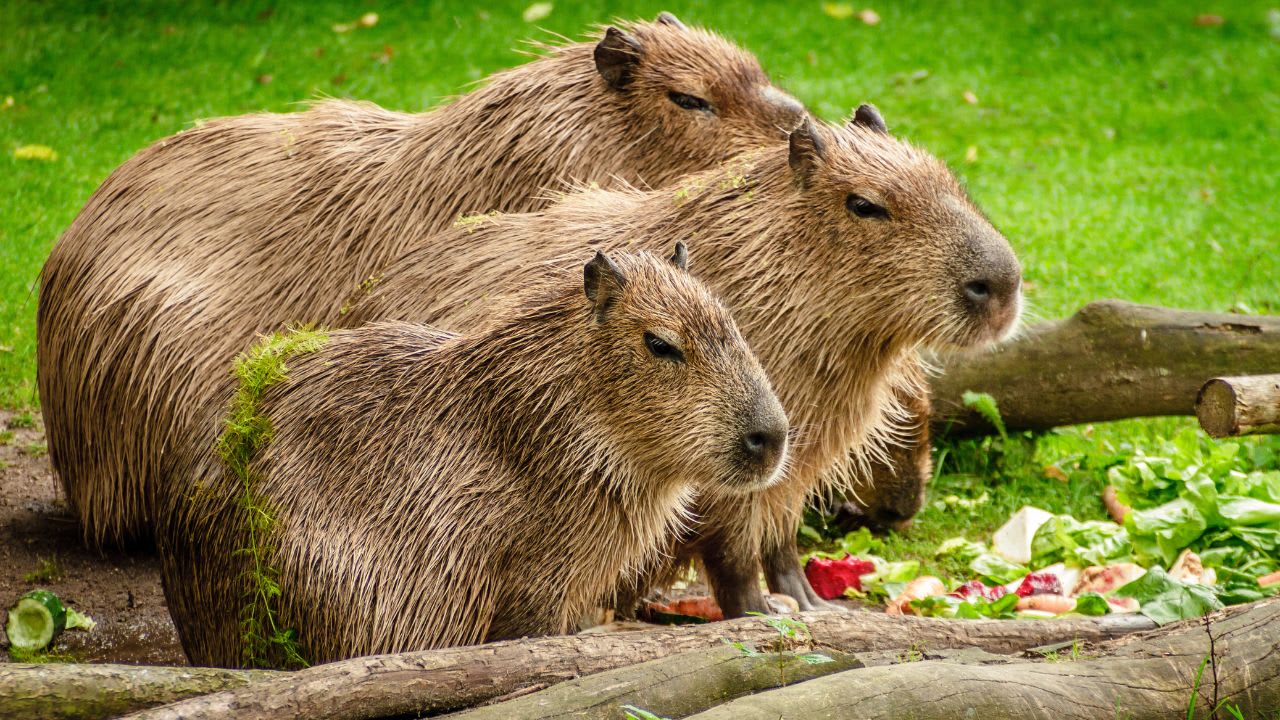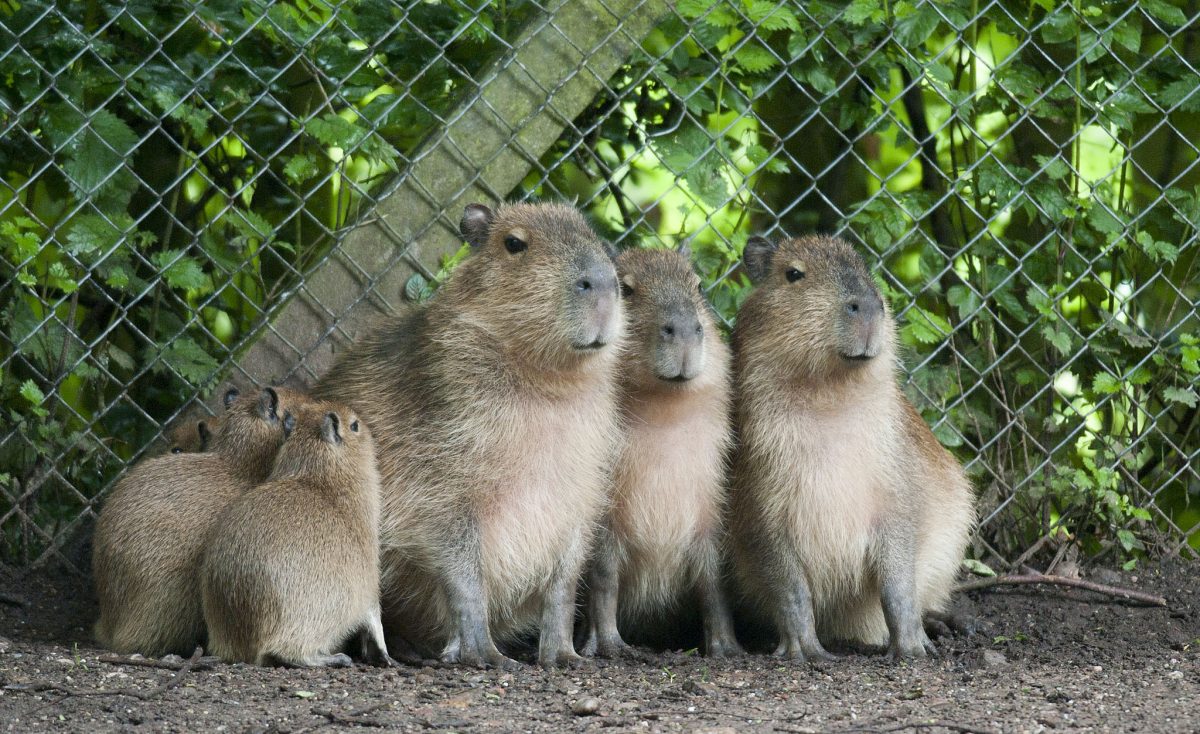Capybaras are strict herbivores, meaning their diet consists entirely of plant matter. In the wild, they primarily consume a variety of grasses and aquatic plants. Their diet is remarkably diverse, reflecting the rich biodiversity of their natural habitats, which include savannas, dense forests near bodies of water, and wetlands across South America.
Grasses: The Staple Food
Grasses form the bulk of a capybara’s diet. They have a particular preference for grasses such as Bermuda grass (Cynodon dactylon) and Panic grass (Panicum spp.). Their strong, ever-growing incisors are well-adapted to nibbling on tough grasses.
Capybaras can spend hours every day grazing on fresh grasses. This behavior ensures they get sufficient fiber to support their digestive system. Interestingly, their diet can vary depending on the season, with some grasses becoming unavailable during the dry months. To adapt, capybaras may switch to eating other types of vegetation, demonstrating their remarkable flexibility.
Aquatic Plants: A Vital Component
Living near water bodies, capybaras have access to a variety of aquatic plants. They consume water hyacinths (Eichhornia crassipes), water lettuce (Pistia stratiotes), and other submerged or floating vegetation. These plants are not only a food source but also provide essential hydration.
Aquatic plants are rich in nutrients and help supplement the capybara’s dietary needs. These plants also play a role in maintaining the health of the ecosystem. By eating aquatic vegetation, capybaras help control the growth of invasive plant species, promoting biodiversity in their habitats.
Fruits and Vegetables: Seasonal Treats
While grasses and aquatic plants dominate their diet, capybaras also eat fruits and vegetables when available. They enjoy munching on squashes, melons, and even some tree bark. Seasonal fruits such as mangoes, bananas, and wild berries are a treat for them. However, during the dry season, they may resort to eating more tree bark and shrubs. This seasonal adaptability is crucial for their survival in the wild, where food availability fluctuates.
Fruits and vegetables also provide capybaras with essential vitamins and minerals. In captivity, offering a variety of fruits can help keep them happy and healthy. However, overfeeding sugary fruits should be avoided to prevent health issues like obesity.
Nutritional Needs of Capybaras
Understanding the nutritional requirements of capybaras is essential for their health and well-being.

Fiber: Essential for Digestion
Fiber is a critical component of a capybara’s diet. Their digestive system is specially adapted to process high-fiber foods, allowing them to extract maximum nutrients from tough, fibrous plant material. Additionally, the consumption of diverse plant matter ensures they receive a range of vitamins and minerals necessary for their bodily functions.
To aid in digestion, capybaras have a unique gastrointestinal system that includes a large cecum, where microbial fermentation breaks down fibrous material. This process is vital for extracting nutrients from their plant-based diet.
Hydration: Staying Cool and Healthy
Given their semi-aquatic nature, capybaras require ample hydration. Their diet of fresh, water-rich plants helps meet their hydration needs. They are often seen drinking water directly from rivers, lakes, and ponds, especially in the dry season when plant moisture content is lower.
Staying near water not only helps capybaras stay hydrated but also allows them to cool off during hot weather. They often submerge themselves in water, which further aids in temperature regulation.
Feeding Habits and Behavior
Capybaras exhibit unique feeding behaviors that contribute to their survival.
Grazing Patterns
Capybaras are known to be crepuscular animals, which means they are most active during dawn and dusk. However, their feeding habits during the day are also noteworthy. They spend a significant portion of their day grazing, which is essential for meeting their high-fiber dietary needs.
Their grazing behavior is methodical and efficient. Capybaras often feed in areas with abundant vegetation, ensuring they can consume sufficient food without expending excessive energy. This strategic feeding behavior is especially important during the dry season when resources are scarce.
Social Feeding Behavior
These herbivores often feed in groups, fostering social bonds while foraging. While competition for food may arise within groups, capybaras display remarkable tolerance, maintaining harmony during feeding sessions.
Group feeding also provides protection against predators. By staying together, capybaras can keep an eye out for threats while still meeting their dietary needs.
Coprophagy: Recycling Nutrients
Capybaras engage in a behavior known as coprophagy, where they eat their own feces. This practice allows them to extract additional nutrients and beneficial bacteria that aid in digestion. By re-ingesting their food, capybaras maximize the nutritional value of their plant-based diet.
Coprophagy is common among herbivorous animals with high-fiber diets. It helps them maintain a healthy gut microbiome, which is crucial for efficient digestion and overall health.
Seasonal Variations in Diet
The availability of food sources for capybaras varies with the seasons.
Wet Season: Abundance of Grasses
During the wet season, capybaras have access to an abundance of fresh grasses, which make up most of their diet. These grasses help them digest food well.
The wet season also brings a variety of aquatic plants and fruits, providing capybaras with diverse food options. This period of abundance allows them to store energy for the challenging dry season.
Dry Season: Adaptability in Food Choices
In the dry season, when grasses are less abundant, capybaras adapt by consuming reeds, grains, melons, and squashes. This flexibility in their diet helps them survive periods when their preferred food sources are scarce.
Capybaras may also rely more heavily on tree bark and shrubs during the dry season. This adaptability highlights their resilience and ability to thrive in diverse environments.
Capybaras in Captivity: Dietary Considerations

Providing a balanced diet for capybaras in captivity is crucial for their health.
Replicating the Natural Diet
In captivity, it’s important to replicate the natural diet of capybaras as closely as possible. This includes providing a variety of grasses, aquatic plants, and occasional fruits and vegetables.
Captive capybaras should also have access to hay, which serves as a reliable source of fiber. Additionally, ensuring they have clean, fresh water is vital for their hydration and overall health.
Avoiding Obesity
One of the primary health concerns for capybaras, especially in captivity, is obesity. Overfeeding, particularly of high-calorie fruits and low-fiber foods, can lead to excessive weight gain. Maintaining a balanced, high-fiber diet and monitoring their weight is crucial.
Providing opportunities for exercise, such as access to large enclosures and swimming areas, can help prevent obesity in captive capybaras.
Vitamin C Supplementation
Like their relative the guinea pig, capybaras cannot synthesize vitamin C and require dietary supplementation to prevent deficiencies such as scurvy. In captivity, it’s essential to provide vitamin C through fresh produce or supplements to maintain their health.
Vitamin C-rich foods such as bell peppers, kale, and oranges can be included in their diet to ensure they receive adequate amounts of this vital nutrient.
FAQs About Capybara Diet

Q: Can capybaras eat human food?
A: It’s best to avoid feeding capybaras human food, as it can disrupt their dietary balance and lead to health issues. Stick to their natural diet of grasses, aquatic plants, and occasional fruits.
Q: How much do capybaras eat daily?
A: An adult capybara can eat an impressive six to eight pounds of grass daily, which is approximately 3% to 4% of their body weight.
Q: Why do capybaras eat their own feces?
A: Capybaras eat their feces to re-ingest beneficial bacteria and maximize nutrient absorption from their fibrous diet. This behavior, known as coprophagy, is common among rodents.
Q: Do capybaras need vitamin C supplements?
A: Absolutely. Capybaras, like humans, cannot produce vitamin C naturally due to a genetic mutation. Therefore, it’s crucial to include vitamin C in their diet to prevent deficiencies such as scurvy, which can lead to symptoms like weakness, hair loss, and gum disease. The recommended daily dose of vitamin C for a capybara is 35 to 50 milligrams per kilogram of body weight. However, it’s important to consult with a veterinarian to determine the exact amount needed for your capybara’s specific needs.
Q: How do capybaras maintain their dental health?
A: Capybaras have ever-growing teeth that require constant wear to prevent overgrowth. Their diet, rich in fibrous plants like grasses and hay, naturally helps in grinding down their teeth. In captivity, providing chew toys or branches can also aid in dental maintenance.
Q: Can capybaras overeat?
A: Yes, especially in captivity where food is abundant. Overeating, particularly of high-calorie fruits and low-fiber foods, can lead to obesity and related health issues. It’s essential to monitor their diet and provide appropriate portion sizes to maintain a healthy weight.
Q: Are there any foods that are toxic to capybaras?
A: Certain foods can be harmful to capybaras. It’s important to avoid feeding them processed human foods, as well as certain fruits and vegetables that may be toxic. Always research and consult with a veterinarian to ensure the safety of the foods you provide.
Q: How can I enrich my capybara’s feeding experience?
A: Providing a varied diet with different textures and flavors can keep your capybara engaged. Additionally, offering food in puzzle feeders or hiding treats around their enclosure can stimulate natural foraging behaviors, promoting mental and physical well-being.
Conclusion
In conclusion, understanding what capybaras eat is essential for their health and happiness. By providing a balanced diet rich in grasses, aquatic plants, and supplemented with necessary vitamins like vitamin C, you can ensure your capybara thrives. Remember, always consult with a veterinarian to tailor the diet to your capybara’s specific needs.
